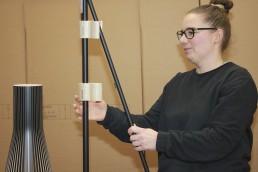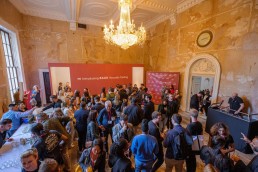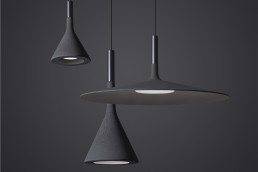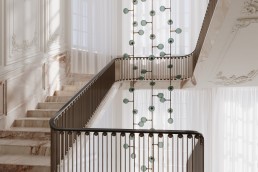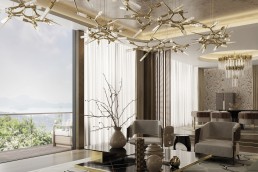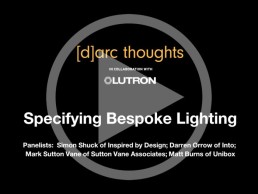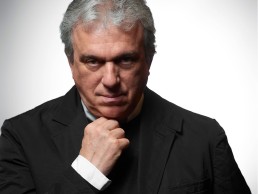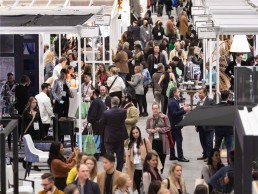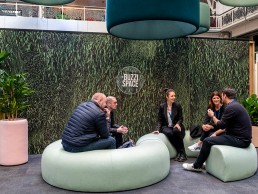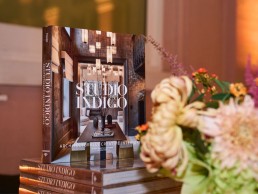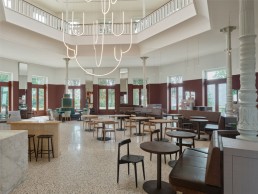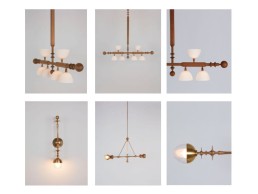Secto Design invests in bio-based packaging
(Finland) - Secto Design has made a significant investment in Finnish start-up company Woamy as an investment into bio-based packaging.
Woamy is an Aalto University spin-out startup which brings to the market a novel ecological cellulose-based foam material to replace unsustainable plastic foams.
”Woamy's mission is fully in line with our own one. Woamy's passion is to make the foam industry sustainable. We as a manufacturer of sustainable design lights want to invest in responsible inventions for a better future - from the actual products all the way to the packaging," states Joakim Jusélius, Board Member of Secto Design. "This brings great opportunities to our own production, where we are driven to eliminate the last remaining trace of plastic still left in our packaging materials. Innovations like this are key to progression and we look forward to this exciting journey with Woamy."
The ecological solution by Woamy to replace plastic foams has been inspired by nature and driven by a decade of scientific research. The material is fully bio-based, biodegradable and recyclable. The material is scalable and adjustable to consumer needs. In addition, it is also lightweight yet super strong, as well as entirely toxic-free. The team behind Woamy continuously seeks innovative ways of exploring cellulose-based foams as suitable alternatives to replace plastic in various applications ranging from protective packaging to shoe insoles as well as building insulation.
With the investment in Woamy, Secto Design continues to support fellow Finnish companies addressing the environmental challenges. In 2020 Secto Design invested in Paptic Ltd, a producer of packaging material made of renewable wood fibres, which looks at substituting plastic in packaging.
Clerkenwell Design Week Announces New Partnership
(UK) - Clerkenwell Design Week (CDW), one of the UK’s leading design festivals, returns to London between 23 – 25 May 2023 – with a stronger-than-ever programme including the addition of Design London.
“With the global design community descending on London in May, Clerkenwell Design Week is the perfect new home for Design London,” says Marlon Cera-Marle, Design Division Director of Media 10. “Amalgamating Design London (which was formerly held in Greenwich in September) into the programme of events further bolsters the experience of Clerkenwell Design Week, as the most anticipated design destination after Milan.”
The 12th edition of CDW will again take place in the heart of Clerkenwell – historically a melting pot of craftspeople and makers, and now home to more creative businesses and architects per square mile than anywhere else in the world. The 2023 festival is set to offer the biggest programme to date – with more than 600 events taking place across the EC1 neighbourhood.
“We’re thrilled to be back with Clerkenwell Design Week this May,” says Cera-Marle. “CDW is always known for being one of the key destinations for specification – as well as discovering new talent and ideas – for architects, interior designers and creative minds alike.
“This year we have a strong line-up of brands, partners and speakers joining our programme – which we look forward to announcing in spring. From product showcases to one-off installations, headline talks to networking events, CDW 2023 will bring some of the most exciting and forward-thinking content to Clerkenwell – while celebrating the best of design and creativity from around the world.”
The 2023 festival welcomes two new additions to its exhibition venues across Clerkenwell, taking the total number to 12. Hosting an array of temporary shows, this year’s venues include:
• Design Fields – home to international furniture and interiors brands
• Contract – home to commercial interiors
• Light – home to international lighting brands
• Project – home to workplace furniture and solutions
• Elements – home to architectural hardware and finishes
• British Collection – home to the best of British interiors brands
• Detail – home to luxury interiors
• Platform – home to emerging design talent
• Old Sessions House – home to brand pop-ups and activations, and also the festival hub offering CDW visitors free access between 23 – 25 May
• Ceramics of Italy – home to Italian tile brands
• (NEW) The Garden – home to outdoor furniture
• (NEW) Catapult – home to contemporary design for office, hospitality and retail
Together, these 12 unique venues will present over 300 design brands and emerging talent – covering furniture, kitchens and bathrooms, textiles, home interior accessories, lighting, materials and surfaces. Some of the participants include Ercol, Dare Studio, Benchmark, Another Country, Christian Watson, James Burleigh, KI, Meridiani, Saba Italia, Samuel Heath, Romo, Ultrafabrics, Spark & Bell, Chelsom, Jonathan Coles, and Curiousa.
Another significant aspect of CDW is its network of showroom partners, with an extensive line-up of topic-led initiatives and events; from product launches and exhibitions to workshops and panel discussions. This year, expect to see over 130 established names from both the UK and overseas – including Ideal Standard, Kohler, VitrA, Cosentino, Gessi, Iris Ceramica, Arper, Fritz Hansen, Fredericia, Icons of Denmark, Modus, Flokk, Orangebox, Bisley, Lintex, Allermuir, Bolon, Camira Fabrics, Formica, Solid Nature, Havwoods, Marazzi, Strata Tiles and Parkside.
Meanwhile, eight destinations across Clerkenwell – including the Goldsmiths’ Centre, Paxton Locher House, Bourne and Hollingsworth, Groupwork, the Museum of the Order of St John, Yotel, Brewhouse Yard and Cowcross Yards – will be taken over by a selection of international brands and trade institutions; for instance, the Korea Federation of Small and Medium Businesses and Incheon City will present a design showcase at the Order of St John.
Alongside product and showroom showcases, CDW will also bring a series of specially commissioned, site-specific installations – as part of CDW Presents – as well as brand activations from the likes of Budweiser Budvar, Baux, Lammhults, Jennifer Newman, Texaa, Swatchbox, Habbio and Universal Fibers to the streets of Clerkenwell during the festival.
Also returning to CDW is Conversations at Clerkenwell – a compelling schedule of daily talks aimed to explore current industry topics, drawing upon insight, opinion and debates from designers, architects and business leaders alike. Curated by brand consultant, Katie Richardson, the 2023 talks will be hosted in a purpose-built theatre in Spa Fields – sponsored by RAK Ceramics. The full line-up of speakers will be revealed in Spring.
Last but not least, throughout the festival, various design studios will open their doors to visitors who can participate in a range of creative workshops – as part of the Fringe programme – whilst enjoying a variety of discounts and deals offered by local food and drink partners.
The 12th edition of Clerkenwell Design Week takes place across EC1, London from 23 – 25 May 2023.
Designed to Last
Foscarini releases a new colour hue, Anthracite, for its Aplomb collection. darc speaks with designers Paolo Lucidi and Luca Pevere about its production journey that began 10 years ago.
Foscarini’s well-known Aplomb pendant has received a new, “non-colour” finish: Anthracite, a neutral grey-toned cement, created in collaboration with a small, Italian family business Crea. Originally designed by Paolo Licidi and Luca Pevere and launched in 2010, the Aplomb’s sleek clean-cut shapes have made the piece a classic in the Foscarini range.
“The protagonist is a special cement developed to be pleasing to the touch, composed of an exclusive fluid mixture poured into a mould,” says the brand. “Aplomb is a re-composition of contrasts: Foscarini has transformed a hard, rough and only slightly pliable material into a lamp with minimal thickness, produced with a craft-based process by Italian experts in cement processing.”
Designers Lucidi and Pevere spoke with darc about the new design and its inspirations, giving an insight into the material choices and process. “The Aplomb concrete pendant has an imperfect surface that gives it an expressive, handmade quality,” describes Pevere. “The design idea was born more than 10 years ago at the end of a design experience in the outdoor field in which we learned to use natural materials such as terracotta, ceramic and natural-based composites. We mainly designed vases where the tactile and visual sensation of the surface was very important. In that period many industrial products were influenced by the first Apple products: smooth, basic, pure. Perfect. By linking the rejection of this homologation, which contaminated many product sectors, to the design experience that has just ended, the inspiration came: a lamp that did not focus on the lighting effect but on its mass when switched off. Its weight and its imperfection. Foscarini was the ideal partner.
“Aplomb is manufactured by family-run Crea Cemento in the province of Brescia. The fixture is part of Foscarini’s wide-ranging Maestrie project, which documents the craftsmanship and know-how behind its finished products. The aim of the project is to look beyond the brand in order to understand the values and culture that have made a particular object possible, the people and places that have gone into its creation. It is the expertise of these craftsmen and artisans that Maestrie showcases and celebrates. The development of the Aplomb lamp is indicative of Foscarini’s creative relationship with its production partners but also demonstrates the artisanal know-how that is the foundation of the success of so many of the high-quality furnishings of Made in Italy.”
The intentional decision to use a cement finish was aimed at “introducing a new material that is little used in the world of lighting”. The Aplomb is a “re-composition of contrasts [that] transformed a hard, rough and poorly pliable material into a lamp with minimal thickness”.
Ideally suited to contemporary interiors, the anthracite version of the Aplomb also features an aluminium neck piece that blends the cement and the cable, matching in a dark hue that aids the transitions of materials.
With regards to the design process, Lucidi explains that it was “tortuous, non-linear, and empirical. The [cement] production process was suited to large castings for architecture or useful for producing heavy elements with a low aesthetic value for common buildings; typically steps, balustrades, fences, manholes, sidewalks, etc.” This forced the design team to challenge the design process to be more flexible and suited to refined product production.
“Our intuitions always had to be verified in the laboratory and modified if the constraints did not allow their feasibility; the concept was immutable, the form was not. The team was so close-knit, passionate and stubborn that it ensured today's Aplomb exactly fit our first design sketch.
“The original drawing for the funnel-shaped pendant was created back in June of 2008. We had approached master craftsman Giovanni Piccinelli, founder of Crea Cemento about producing the design in concrete for Foscarini. We wanted him to execute a thin, cast concrete pendant, hung by a slender cylindrical neck, all of concrete. But upon seeing the specifications, Piccinelli said it could not be done. Foscarini insisted on the project, asking to reconsider. 'When you’re being challenged, you’re probably in a good position to find something new,' Carlo Urbinati, Foscarini Founder and President, says. 'Often, the real meaning of ‘it cannot be done’ is actually ‘I’ve just never done that before.’ Piccinelli went back to the drawing board and began crafting fiberglass moulds for prototypes. He had made thousands of moulds during his decades-long career, but they had been for pillars and staircases, not fancy pendants. The scale of Aplomb was entirely different.
“Meanwhile, the economic downturn of 2008 hit the construction industry hard. As Crea’s other business dried up, Piccinelli and his sons kept working on prototypes for Aplomb, spending more than two years perfecting the recipe of sand, cement, leveling compounds, and other additives to produce a mixture that was fluid enough to pour, yet would retain its shape without breaking. Making matters more complicated, Foscarini had certain requirements, such as a perfectly turned edge and a smooth finish unmarred by large pockmarks. All of these elements could be thrown off by a simple change in temperature or humidity in the workshop. Finally, the team hit upon a recipe that produces a pendant that is sturdy yet delicate. (The name “Aplomb'' refers to the construction tool that uses gravity to determine a vertical line—a plumb bob— and also to having an attitude of poise or self-confidence.) In 2010, the pendant officially went into production.”
As mentioned, the first challenge the team faced was Piccinelli’s first response that it was impossible to make due to the fragility of the material in such a thin state. Further challenges they had to overcome included establishing a range of variability, a “standardised variation”, especially with regards to surface yield. Thirdly, longterm, the thermal shoches due to ignition broke the lamp.
Lucidi continues, walking us through the construction stages of putting the Aplomb together. “We initially walked the reinforced concrete road by incorporating wire and steel rod into the concrete. We soon realised that this involved flaws and breakages. Today the Aplomb is made of concrete, single material. Components made of other materials are assembled later and grant the tolerances and expansions it needs.
“The mixture of cement, sand, water, self-leveling compound, and other additives used to make Aplomb is proprietary, and varies according to the temperature, humidity, and presence or absence of colour pigments. Before filling the mould, Ndiaye Mamadou (from Crea) uses two vessels to decant the concrete to help eliminate large air bubbles, then lets it sit until the remaining bubbles rise to the surface. Then he slowly pours the mixture into the mould. Sandblasting gives the Aplomb its soft exterior, yet won’t obscure the signature imperfections that are formed by small air bubbles during mixing. Each pendant is sandblasted both inside and out for consistency.
“On the one hand the final sanding does away with any brutalist effect on the cement itself, and on the other there is emphasis on the controlled irregularity of the material thanks to a grain size with pores open to various extents, making each lamp unique, just slightly different from the next.
“Foscarini’s certain requirements meant all of these elements could be thrown off by a simple change in temperature or humidity in the workshop. As Carlo Piccinelli said 'We weigh the ingredients and mix them according to a special recipe, but the success ultimately relies on the sensitivity of the person doing the mixing.'”
With each Aplomb being made by hand and the assembly completed separately, the attention to detail is evident. “What is sophisticated and rare is the know-how and sensitivity of those who produce it,” adds Pevere. “The bricklayer's plumb line effect was one of the sensations we wanted to retain throughout. A weight that stretched the self-supporting electric cable properly.
“It is a successful lamp because it does not just suit one specific sector but is very transversal: residential, contract, hospitality, corporate, etc. It can be used in assonance in warm and material environments or by creating a pleasant contrast in extremely minimal and pure environments.
“Aplomb is the first concrete lamp offered on the market with these technical specifications. As concrete is usually used in outdoor spaces and in large quantities like for floors or panels, Aplomb brings a lighter, minimalistic approach to concrete into an indoor space–making it a very unique focal point in any space. Aplomb is perfect for adding an industrial touch to a space without making it feel cold or heavy. Concrete is durable, versatile, rugged, authentic and has a natural aesthetic appeal–and paired with Aplomb's intricate and delicate form of its funnel-shaped pendant, it adds a beautiful contrast to any room.
“Every new lamp that enters the Foscarini catalogue adds something new. Concrete was a new material for Foscarini, never used before in a lamp. It is a product designed over 10 years ago, and we think it is aging well. Not only in the panorama of Foscarini products but we also believe in the places it illuminates.”
Aplomb’s family of lightweight lamps is available in three sizes and various colours. Its proportions enable it to be used alone, e.g. on a coffee table, in linear configurations to light a surface, or in compositions at different heights. The built-in LED light source recessed into the body of the lamp sends a wide beam of light down towards the underlying surface.
Hyde Park Château London, UK
The Hyde Park Chateâu was envisioned as a French chateâu-style inspired residence with monumental architectural proportions and refined luxurious materials.
Every room in the house unveils as a sequence of narratives framed by contemporary art and furniture. Interiors and architecture was completed by Javier Robles Studio, with bespoke lighting and furniture by Robles’ brand, Lumifer.
A major focal point of the project is Lumifer’s monumental custom Helix lighting installation, which accentuates the materials and geometry of the grand staircase.
The living room, dining room, and foyer follow the same style and architectural proportions, adorned by minimal decorative themes that are unified by the diverse and harmonious lighting and furniture collections designed by Robles and made by Lumifer.
Each Lumifer piece was carefully selected, customised, and coordinated to create a seamless and timeless design vocabulary magnified by the craftsmanship and richness of materials and finishes that are synonymous with the brand.
Lighting collections featured throughout the property include Helix, Navis, NYX, Switch, Titan, and Bouy.
Private Apartment, Hong Kong
For this new project, Luxxu pays homage to the architectural style of Hong Kong, introducing a modern and contemporary feel to the luxury oasis. Structure alone, the penthouse was imagined as a sort of paradisial landscape with sweeping city views, and then, Luxxu decorated the interiors with high-end designs that epitomised the modern notion of luxury but in a lighter yet vigorous colour scheme, especially playing on the timeless appeal of various shades of brown and neutral hues, eye-catching gold accents, and an abundance of greenery. All divisions benefit from a bright atmosphere with floor-to-ceiling windows that allow one to embrace the region’s phenomenal skyline.
As we move through the apartment, multiple Luxxu products illuminate the way. Starting in the hallway, Luxxu’s Waterfall II wall lamp illuminates the area with a unique glow courtesy of its gold-plated brass frames and crystal tubes. For the living room, every detail was thoroughly thought out to make a statement. The tray ceiling and the lighted brass walls immediately set the tone whereas the Shard suspension by Luxxu becomes a lighting installation in its own right.
In the dining room, the Burj chandelier offers a more opulent nature while becoming an ode to the modern age. In the bathroom, besides plenty of natural lighting, this space also benefits from the harmonious and architectural allure of the Pharo lighting fixtures.
What better way to boost your creativity than to work to the sight of the most magnificent mountain views. Luxxu took this concept and designed a highly simulative interior with floor-to-ceiling windows in the office. Here, the Tycho rectangular suspension was selected as the main luminaire, while the Waterfall technical wall lamp and the Tycho table lamp back up its stately layout.
Specifying Bespoke Lighting
As part of the LiGHT 22 talks programme, Specifying Bespoke Lighting looked at how popular bespoke lighting services are becoming? What kind of projects call for it? What are some of the complexities and processes involved? Featuring some of the leading designers in bespoke lighting, this talk aimed to answer all of these questions and more.
Panellists included: Simon Shuck of Inspired by Design; Darren Orrow of Into; Mark Sutton Vane of Sutton Vane Associates; Matt Burns of Unibox.
Venini appoints new Art Director
(Italy) - Architect and designer Marco Piva has taken up the role of Art Director at Venini with the aim of redefining the company’s product-focused creative path, starting from the study of its historic and cultural archival heritage.
The Milanese designer is particularly interested in the ability of an object to intercept the aesthetic and functional “expectations” of users and, consequently, in the reaction that such an object is able to elicit in them. Bringing this attitude into play, he will work on enhancing the brand’s allure, interpreting it and capturing the attention of the brand’s enthusiasts and collectors. With his long-standing experience and professionalism, Piva will also devote particular attention and energy to engaging and developing the brand in the luxury contract world with hotels, restaurants and exclusive residences with the opportunity of hosting Venini products and installations.
A traveller even before becoming a designer, Piva is an innovator dedicated to creating unique design solutions characterised by style freedom, functionality and emotion. Studio Marco Piva, with major offices in Milan and Shanghai, has carried out important projects in Italy and abroad such as the prestigious Excelsior Hotel Gallia in Milan, the Pantheon Iconic Hotel in Rome, Palazzo Nani in Venice and the Port Palace in Montecarlo, in addition to multiple projects in Asia such as the FengTai Financial Center in Beijing, the Culture and Art Center Design of Yuhang and the Tonino Lamborghini Towers complex in Chengdu, which will be inaugurated in the spring of 2023.
Piva says proudly about his new role as art director of the Furnace: “It is a great satisfaction to be a part of a prestigious company of the calibre of Venini, rooted in Murano’s traditional art of glassmaking but with a keen eye to the future. The brand has collaborated with artists and designers such as Carlo Scarpa and Gio Ponti, who have made the history of design in the last century, and it is a privilege for me to work to contribute to its ongoing success.”
Silvia Damiani, President of Venini, has said: “I’m really excited about this new collaboration. Not only does Marco Piva have extraordinary creative experience, but he has also taken part in prestigious projects on an international scale. His figure is important on the Italian and foreign cultural scene. Marco Piva will project Venini towards an even more cosmopolitan dimension.”
BDNY puts a spotlight on thought-provoking design
(USA) - The conference for the boutique hospitality and lifestyle industry gathered nearly 13,000 designers, architects, brand executives, hoteliers, developers, purchasers, manufacturers, and other professionals from 47 countries at the Javits Center on November 13-14 to experience new products, engaging conversations, and strategic networking events.
BDNY returned strongly with a sold-out Kickoff Party on November 12 and continued with a noticeable increase in attendance. In comparison to 2021, that equated to a 65% increase in overall attendance, a 61% increase in qualified buyers, a 47% increase in exhibitors, as well as record-breaking gains in onsite registration over the past two shows—up 737% over 2021 and up 247% over 2019.
“It was an incredible few days in New York—from kicking off with a sold-out Platinum Circle Gala to seeing so many excited faces representing a who’s who of the industry on the show floor to ending with a packed house at the Gold Key Awards,” says Stacy Shoemaker Rauen, editor in chief of Hospitality Design magazine and SVP, Design Group at Emerald. “I think everyone walked away invigorated and inspired—I know I did.”
“The positive response we received from our exhibitors, attendees, and design partners has proven that business is back and better than ever this year. We are looking forward to continuing to expand our exposure and to deliver smart and targeted programming for the hospitality design community in 2023,” states Kevin Gaffney, Group Vice President, Emerald Design Group.
Thousands of industry professionals explored new products from nearly 600 exhibitors and learned about the latest trends and issues in hospitality from sessions covering innovation in design, wellness and mindfulness, navigating inclusivity, and the future of hospitality. While sustainability in design has always been important, it became more central in both products and projects at this year's BDNY. At the ReWild by Westin Designed Space, the environment was top of mind with abundant greenery and features like The Well, which contained a plastic-free source of water for visitors. At the booths, an emphasis on eco-friendly was pervasive from the recyclability of iSiMAR’s aluminium outdoor furniture to a line of textiles from Valley Forge Fabrics created from reclaimed and repurposed ocean plastic. Other trends that appeared throughout the exhibitor booths included a focus on 1970s-themed shapes and colours and curved silhouettes among chairs, sofas, and more.
Highlights of this year’s BDNY included the debut of its four signature Designed Spaces. Created by major interior and architecture teams, and hospitality companies, the spaces rely on products from BDNY exhibitors and sponsors as sources for inspiration, design, and concept. This year’s Designed Spaces included Revive by Element designed by The Society; ReWild by Westin designed by the EoA; Better-Verse by DLR Group; and Posta by WorldHotels Crafted Collection designed by EDG. In addition to presenting impressive designs, these spaces featured pop-up talks and food and drink throughout the two days.
BDNY Meet, a platform for targeted connections between exhibitors and attendees, continued to serve as an important matchmaking tool both prior to and onsite at the trade fair. More than 3,000 attendees and exhibitors engaged with BDNY Meet by visiting matched profiles and sending meeting requests.
Spanning 14 categories for hospitality interiors, the Best of BDNY 2022 Product Design Competition and BDNY Best Exhibit Competition celebrate designers and manufacturers of products that demonstrate aesthetic progress, functionality, and innovation. This year’s Best Exhibit Competition winners were Mexa Diseño (Small), CM Hospitality (Medium), and Opiary (Large). Opiary also won the Best in Show award, and Arteriors won the Lighting category.
Preceding BDNY, the 33rd Annual Platinum Circle Awards Gala, hosted by Hospitality Design magazine, took place on Friday, November 11 at Gotham Hall in New York, where seven hospitality leaders were honoured for their lifetime achievements: Ronnie Bray and Elisa Whaler, Bray Whaler; Ken Fulk, Ken Fulk Inc.; Neil Jacobs, Six Senses; Sheila Johnson, Salamander Hotels & Resorts; and Barbara Parker and Miriam Torres, Parker-Torres Design.
Closing out the week of events, BDNY hosted the annual Gold Key Awards celebration on Monday, November 14 at Cipriani 42nd Street, where winners in 24 project categories—from fine dining restaurant and resort to suite—were announced.
The next edition of BDNY will be held at Javits Center, November 12-13, 2023.
2023 theme announced for Workspace Design Show
(UK) – Workspace Design Show returns for 2023 after its inaugural edition last year.
Workspace Design Show will take place at the Business Design Centre, London, on 27 – 28 February, and is getting ready to host a whole range of creatives from the UK’s workplace industry, with the theme of this year’s show being ‘Destination Workplace’.
Gensler will be designing the show entrance, with the theme ‘Destination Workplace Rebirth’. Becky Spenceley, Design Director at Gensler, who is leading the project, said: “It feels like there has never been a more exciting and yet equally unknown time in the future of workplace design.
“We are inspired by this synergy between a new era of workplace and a new outlook on how we can care for our planet, and how we as designers can affect that through pioneering and sustainable design. It’s about fresh perspectives to enable new ways of working and create unique and tailored destinations for people, hence the overarching theme of Rebirth.”
Over the course of the event there will be a diverse range of speakers, within an enticing talks programme, providing three talks theatres which attendees can choose from.
Refreshing, post-Covid opinions will be discussed in the Talks Lounge, curated by The Furniture Practice. In addition, attendees will be able to listen to the leading lights from architecture and design, and end-users talking about the latest trends, challenges and innovations in the workplace sector.
New to this year is the Bio Materials exhibition, designed by BIOHM, with biological systems at the heart of it’s inspiration. This will combine ideologies of the circular economy and human-centred design with future-tech, representing an exciting opportunity for visitors to discover advanced materials, that will be crucial to the future of design.
Architecture practice BDP is responsible for ‘Change by Design’ a lounge space concept for the 2023 Workspace Design Show. This will provide a discussion piece surrounding the current climate crisis, and will question the impact of workplace design on the natural environment. It represents a problem-solving approach that will demonstrate how the use of recycled, reused and bio materials in design projects can help to shape a low-carbon future.
The FIS, (Finishes & Interiors Sector) Innovation awards will also take place at the show, recognising outstanding innovation in the finishes and interiors sector across various categories. The Workspace Design Show party will also be making a welcome return.
The show will also provide visitors with the chance to explore the latest product launches that are transforming the employee experience in our workplaces, creating spaces for people to harbour creativity and enjoy working in.
Studio Indigo launches new book
(UK) - Studio Indigo celebrated its latest book publication 'Studio Indigo: Architecturally Creative Interiors' on Thursday 10 November in London's iconic Wallace Collection.
The evening brought together a milieu of the design industry including the Studio's Clients and friends who gathered within the wonderfully lit indoor courtyard. The historic 18th Century Museum provided the perfect backdrop to toast the Studio's 17 years in the industry.
Creative Director and Founder, Mike Fisher says: "I was truly humbled to see so many people coming and supporting the Studio and all that we have achieved. When I look back at the beginnings of Studio Indigo and my ambitions to have a small five-man team, and to see it has now grown into a team of 50 from such diverse backgrounds and skills it really brings a smile to my face."
CEO, James Kandutsch says: "The book launch was a tremendous success and a great opportunity to bring clients, friends and advocates together to celebrate our journey. It’s been inspiring, exhilarating, fun and taken us to places we could never have imagined! It really does take an enormous amount of effort and collaboration with many talented people involved to create the spectacular work we do. I hope readers will smile and find joy as they read through the pages of our new book.”
The new coffee-table book encapsulates 16 unique and diverse projects that explore different facets of multi-disciplinary design, form and colour. From historic homes to contemporary city townhouses to homes on the sea, the new book depicts the studio's ability to bring its experience to various industries.
Studio Indigo: Architecturally Creative Interiors by Mike Fisher is published by Vendome Press and is out now.
Arnhem Museum, Netherlands
Studio Modijefsky has created a new interior scheme for the Arnhem Museum in the Netherlands. darc speaks with senior designer Natalia Nikolopoulou to find out more about the studios approach.
Museum Arnhem, in The Netherlands, is home to modern, contemporary, and applied art and design, with a special focus on female artists. The public spaces were recently renovated by Studio Modijefsky, which included the entrance, café, and shop on the ground floor, plus an event space and activity room on the first floor.
The museum’s iconic dome is at the centre of it all, and Studio Modijefsky worked hard to ensure a new design language united these areas spread across the cavernous space. The design language was inspired by the building’s past and present; its origins as a gentleman’s club and the “Magic Realism” of the museum’s current collection. “While seemingly worlds apart, both these guises have escapism at their heart, from the men who used to evade everyday life to the artists creating fantastical takes on reality,” says the studio. “The new spaces designed by [us] take visitors on the same journey by playing with perspective and offering pathways into other dimensions.”
The museum’s core value: “from the heart, looking further, from now on and with quality”, is reflected in the new interiors of the building and its collections, which spread into new wings of the museum.
Senior designer on the project Natalia Nikolopoulou sat down with darc to elaborate on the museum’s new aesthetic that was completed in May 2022.
“Museum Arnhem approached Studio Modijefsky in the summer of 2020, and the initial brief was to create a design for the public spaces of the museum; main entrance, café, shop, and activity room. [They wanted] a design that represents the identity and values of Museum Arnhem, respects its surroundings, and the architecture of the building. A destination for art, culture, and nature lovers in a completely renovated building.”
One of the major challenges that the team faced when starting out on the design process was factoring in all the ideas, suggestions, and thoughts from different stakeholders. “[This] was challenging as they all had various and interesting points of view,” says Nikolopoulou. “The ability of Studio Modijefsky to combine and unite all these ideas was the turning point of this design: we overcame the challenge by translating the client’s own desires into a design that clearly speaks Modijefsky’s language.”
Using a selection of bespoke fixtures designed by Studio Modijefsky and created by Signwise, Fiction Factory, as well as some architectural pieces from Modular, a stunning aesthetic was created throughout the museum.


In the entrance, the “Magic Realism” atmosphere begins with a bespoke lightbox hanging above the reception desk, mirroring the desk’s shape. “ It’s a floating version of this piece of furniture hanging above. It’s made like a kite, with sticks that span from corner to corner, and uses the fabric that is also used for kites,” describes Nikolopoulou.
A small (by comparison) chandelier hangs in solitude hinting at its larger version that is yet to be seen on the other side of the entrance. Moving through into the dome area, visitors can enjoy an open-plan zoned space that houses the café and museum shop. Each area is distinguished by a unique identity and set of materials that are linked to different themes of the museum’s collection. Eyes are drawn to a large custom-made chandelier that makes full use of the dome’s impressive height and unites the space. Formed of illuminated curves in different shades of white that hang together in a cluster of varying heights, the chandelier’s shapes mirror the outline cupola above it and the windows above.
Nikolopoulou adds: “The chandelier is inspired by the architecture of the building. Taking the outline of the building’s dome and the outline of the windows situated in the lantern all the way to the top of the dome - we created two basic shapes, that we flipped upside down and used to compose a spatial arrangement with.
“The chandelier elements are divided into groups; each group slowly glows at its own pace.
We wanted illuminating tubes that give light in every direction so we used a system of custom LED tubes, a product we discovered through the executing party. It works really well and provides the same neon tube effect that we were aiming for. The LED tubes are a bit bigger than standard neon tubes, which works well with the proportion of the dome.
We programmed the three-tiered clusters of light to slowly pulse throughout the day.
“A smaller version of the grand chandelier hangs in the entrance of the museum, which can be seen from the outside looking in. And, a second even smaller one appears when standing in the entrance area looking through a window into the dome area, right on the ceiling close to the entrance space. This one leads the visitor to the dome where the big chandelier greets you the moment you enter the space.”
In order to support this grand chandelier, a special suspension system was installed to ensure the piece hangs comfortably and safely in the centre of the dome. A high seating area, characterised by a lilac backdrop behind the bar, has mirrors to reflect all the colours and structures used in the seating area. As they are positioned higher than the dark wooden plinth, they invite visitors to look up at the reflection of the chandelier. The activity and event space on the first floor also benefit from the large chandelier that transcends this floor, enlightening it throughout at different heights and points.
Speaking of how the decorative lighting elements worked alongside the architecture, Nikolopoulou says: “The existing building served as a blank canvas upon which the design was drawn. Its architectural features are enhanced by the custom furniture that wraps around the monumental columns, delineating the perimeter of the café at the very centre of the area. A lower darker layer creates a contrast with the brightness coming through the big windows, leading the eye towards the dome where the custom chandelier lightens up the entire building.”
Reflecting on the project, Nikolopoulou concludes: “With the collection moving into the new wings of the museum, the interior of this monumental building became a work of art itself, expressing Museum Arnhem’s core values, inviting the visitors to escape reality in their new surroundings.
“A museum inspires you in a different way than a bar or a restaurant. To unite the areas spread across this cavernous expanse, we created a new design language inspired by aspects of the building’s past and present.
“If [we could have changed] anything, we would add back an initial element of the design, which was let go during the process - a large yellow mirror behind the entrance desk. This large mirror was supposed to be placed parallel to a silver mirror, creating a series of smaller and smaller reflections that appear to recede to infinity. This would have transformed the main entrance into a piece of art itself, inviting the visitor into an infinite mirror play. I hope that this feature will be eventually realised.”
Images: Maarten Willemstein
Roll & Hill launches collection with Jessica Helgerson
(USA) - Brooklyn-based lighting and furniture company Roll & Hill launches Rue Sala and Del Playa, two lighting collections designed by interior designer Jessica Helgerson.
Known for thoughtful and artful interior design that combines historic architecture with bright and playful modern details, Jessica Helgerson’s design studio is based in Portland, Oregon, with a new office in Paris.
Rue Sala and Del Playa find unity in Helgerson’s love of turned and crafted materials, but diverge to reflect her upbringing in differing milieus. Helgerson was raised in Isla Vista, California in the 70s, and the materials for Del Playa—wood and ceramic—represent the handcrafted feel of the surroundings from her childhood spent on the Del Playa Drive beach. Rue Sala, on the other hand, speaks to her summers spent in France; the use of glass and bronze suggests the flamboyance and the historical feel of furnishings and other elegant objects that caught her eye.
This is Jessica Helgerson’s first line for Roll & Hill and her first product design that reaches beyond the realm of her clients. This is also Roll & Hill’s first collaboration with an interior designer. When asked her reasons for working with Roll & Hill, Helgerson says: “Lighting is such a special, bright part of an interior, like the fancy last piece of jewellery that makes the outfit, and Roll & Hill does it better than just about anyone.”
Del Playa consists of four pieces – single-arm sconce, double-arm sconce, two-arm pendant, and four-arm pendant. Rue Sala is available as a pendant sconce, single sconce, two-arm sconce, two-arm pendant, four-arm pendant, and six-arm pendant, and each piece is available in 120v or 240v.
The pieces will be on view at the Roll & Hill showroom in New York City’s SoHo neighbourhood and will be launched in Europe on December 5 with an event at the Triode showroom in Paris.


